The Little Book of Bull’s Eye Investing: Finding Value, Generating Absolute Returns, and Controlling Risk in Turbulent Markets
$11.83
| Author(s) | |
|---|---|
| Format |
|
| Pages |
86 |
| Publication Year |
2012 |
In The Little Book of Bull’s Eye Investing, acclaimed investment expert John Mauldin teaches you how to read the direction of the markets to make decisions that capitalize on today’s investment opportunities. A practical road map to what’s in store for the markets to help you stay ahead of the curve, the book debunks many of the myths that have come to govern investment logic, particularly the buy-and-hold, relative return vehicles that Wall Street peddles to unsuspecting investors. Giving you a clear view of the trends shaping the markets right now which are likely to provide investment options for the decade ahead, The Little Book of Bull’s Eye Investing teaches the value of careful research before you put your money to work.
Author’s Introduction:
EVERY HUNTER KNOWS YOU don’t shoot where the duck is; you shoot where the duck is going to be. You’ve got to “lead the duck.” If you aim where the duck is at the moment you shoot, you’ll miss it. Bull’s Eye Investing simply attempts to apply that same principle to the markets. In this book, I hope to give you an idea of the broad trends that I believe are at work now and will persist for the remainder of this decade. Then I’ll help you target your investments to take advantage of those trends.
When I was invited to do this Little Book of Bull’s Eye Investing, I wondered whether the original Bull’s Eye Investing (written nine years ago and dense in data and research, and not little at all) could be shortened and still deliver what put the book on the best-seller lists and earned it the top spot on Forbes publisher Rich Karlgaard’s roll call of the decade’s most important books on investing. It has since been published in several foreign languages and is still in print.
Thinking about doing the Little Book made me go back and carefully read the original, and I was pleased to find how much of it is still useful today. Much of the research that it reports is timeless and still will be valuable a generation from now. Many of the predictions, whether by luck or skill, were spot on. We are still on the path I mapped out but are much further along it. The task for the Little Book is to collect the parts that have held up well and then bring things up to date, and introduce new readers to the concept of Bull’s Eye Investing.
As I write this introduction (the final element), I’ve just come from Hong Kong, where Bull’s Eye Investing has something of a serious following. Publishers are eager to do a Chinese-language version for distribution in Hong Kong and the mainland. The principles of the long-term ebb and flow of markets really do work wherever human beings are involved in investing, which is to say, everywhere. Successful investing for the remainder of this decade will mean doing things differently from what people did so profitably in the 1980s and 1990s and from what Wall Street is still telling people to do.
We started the last bull market, in 1980, with high interest rates, very high inflation, and low stock market valuations. All the elements were in place to launch the greatest bull market in history. The environment now is just the opposite. Stock market valuations are still relatively high (though well down from the stratosphere where they were flying at the beginning of the decade), and interest rates will eventually have to go up. In addition, gold is volatile, as is the dollar against other currencies, and the twin deficits of trade and government debt stare us in the face.
Contents:
- It’s Good to Be King
- Rules of Engagement
- Faith versus History
- The Trend Is Your Friend (Until It Isn’t)
- Investors Behaving Badly
- Dancing with the Bear
- The Essence of Bull’s Eye Investing
- The Sisyphus Syndrome
- Spreading the Pain Around
- Leading the Duck
The Little Book of Bull's Eye Investing: Finding Value, Generating Absolute Returns, and Controlling Risk in Turbulent Markets By John Mauldin pdf









